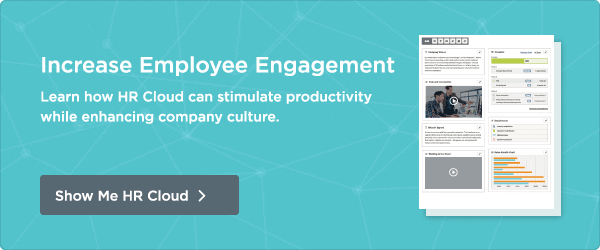Great HR is Technology-Driven HR (see why that's true)



 Cut onboarding time
by 60%—here's the
Ultimate Checklist
that helped do it.
Cut onboarding time
by 60%—here's the
Ultimate Checklist
that helped do it.

I had a conversation with a colleague the other day about the upcoming HR Technology Conference and Exposition. “Do HR practitioners attend?” he asked. “I always thought that conference was for IT people.”
I had to set him straight.
I told him that not only do HR professionals attend (en masse!) but they come to learn. Just a glance at the agenda shows that session topics cover current and future trends across the entire spectrum of human resources; everything from workforce planning to talent management to employee communications. The Expo Hall, my favorite place to get lost for hours, is certainly one of the largest gatherings of HR technology vendors in one place at one time.
Of course, as the name implies, everything at the conference is anchored by technology. Unfortunately that still makes quite a number of HR professionals nervous and hesitant; they wonder if they’re up to the task of diving into a world populated by programmers, UI designers, and people who discuss algorithms for fun.
They shouldn’t be scared. They should be curious.
The Human Resource Competency Study (HRCS), conducted by the University of Michigan and the RBL Group, has been the largest global study on HR competencies for close to 30 years. The focus of the study has been to answer the question "What knowledge and abilities are necessary for successful HR professionals and HR Departments?"
Tweet: What knowledge is necessary for successful HR pros? @HRCloud
The results of the 2015 Competency Study (directed by Dave Kryscynski and Mike Ulrich, with Dave Ulrich and Wayne Brockbank acting as project principals) will be released in October and we may find adjustments to the 2012 HR Competency Model that was released several years ago. In that study the researchers identified six HR competence domains: Strategic Positioner, Credible Activist, Capability Builder, Change Champion, HR Innovator and Integrator, and Technology Proponent.
Isn’t that a wonderful thing? I think so!
Here is what the researchers/authors have to say about the Technology Proponent competency:
At a basic level, HR professionals need to use technology to more efficiently deliver HR administrative systems like benefits, payroll processing, healthcare costs, and other administrative services. In addition, HR professionals need to use technology to help people stay connected with each other. This means that technology plays an increasingly important role in improving communications, do administrative work more efficiently, and connecting inside employees to outside customers. An emerging technology trend is using technology as a relationship building tool through social media. Leveraging social media enables the business to position itself for future growth. HR professionals who understand technology will create improved organizational identity outside the company and improve social relationships inside the company. As technology exponents HR professionals have to access, advocate, analyze and align technology for information, efficiency, and relationships.
We surely know by now that human resources teams can use technology to get tasks done in a more effective and efficient manner. We’ve definitely been learning that the use of technology can improve organizational communication as we have more ways than ever to connect with team members. And we’ve definitely found that encouraging our employees to connect with each other as well as with outside stakeholders not only strengthens relationships but also leads to collaboration, innovation, and growth.
Quite often, when we implement technology solutions in our organization, we do so by taking steps one after the other; we shore up and strengthen our core HR systems by implementing an HRMS that manages employee information, centralizes our data in a seamless manner, and allows us (hallelujah!) to get rid of disconnected systems, spreadsheets, and pieces of paper. We implement onboarding software to further streamline processes and ensure new employees are immediately connected to both our company culture and their co-workers. By then we’ve learned how effective – and easy – it is to use technology to share information and build connections so we add technologies that reinforce culture while driving connections and engagement.
Good stuff.
There’s also some good stuff at the HR Tech Conference. A few of the sessions I’m looking forward to attending include:
• Activate Your Employees as Ambassadors: An Employment Branding Guide to Finding New Talent
• Employee Engagement: What’s It Really Worth? (Dr. Andrew Chamberlain, Chief Economist with Glassdoor)
• Where Should You Focus Your Employee Engagement Investments? (Insights from Quantum Workplace’s Best Places to Work)
Attract and hire the right people, onboard them to your unique company culture, and identify the best means and methods to engage and retain them. As a technology proponent you will also effectively use tech to provide for access, alignment, and analysis across all these areas of the employee lifecycle.

Keep Reading
A Closer Look at Our New Integration With Bridge
If you want to empower your staff, a learning management system (LMS) can help you ensure
Want to Write for Us? Check out our Blog Guidelines | HR Cloud
If you’re interested in writing an article for HR Cloud’s blog, you’ve come to the right
Best-In-Class Onboarding is Synonymous with Elite Security
Today’s quintessential HR department is a little different than the stereotypical image
Like What You Hear?
We'd love to chat with you more about how HR Cloud® can support your business's HR needs. Book Your Free Demo

Build a Culture of Recognition. Boost Engagement. Guaranteed.
Workmates empowers employees to stay informed, connected, and appreciated—whether they’re on the front line, in the office, or remote. Recognition drives 12x higher engagement.Trusted by industry leaders in every sector




Cut Onboarding Costs by 60%.
Take the confusion and follow-ups out of onboarding with automated workflows, digital forms, and structured portals—so new hires ramp faster 3X quicker.Trusted by industry leaders in every sector





